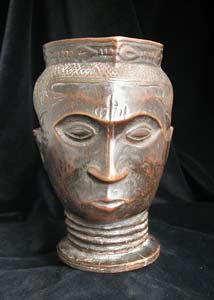Kuba Cephalomorphic Palm Wine Cup, 19th Century CE - 20th Century CE
Wood
11.4 x 17.5 cm
4 1/2 x 6 7/8 in
4 1/2 x 6 7/8 in
PF.5712
Further images
Palm wine, obtained from the raffia palm tree, is the most popular beverage consumed in the areas inhabited by the Kuba tribe. Today, plastic cups or glasses are used for...
Palm wine, obtained from the raffia palm tree, is the most popular beverage consumed in the areas inhabited by the Kuba tribe. Today, plastic cups or glasses are used for drinking it; however, during the 19th and early 20th centuries, decorated wooden cups were carved by several tribes across the Southern Savanna. The Kuba specifically are known for their figural and cephalomorphic (head-shaped) cups. This vessel is a perfect example of the masterful artistry of the Kuba woodcarvers. The head is emphasized above all else; the truncated neck and circular flaring base are much of an afterthought. The facial features are finely delineated, specifically the arching brows, almond-shaped eyes, and strongly defined jaw line. Decorative, or perhaps ceremonial, scarifications can be seen along the temples and forehead. The distinctive hairline is actually representative of a typical Kuba coiffure: the hair was pulled back and the hairline was shaved straight across the top of the forehead except for a sharp angle at the temples. A handle, carved with a small head on it, rises out of the back of the head and curves down into the nape of the neck. Most intriguing is the looping pattern, reminiscent of the infinity sign with an extra circle, carved on the back of the head above the handle. A cup such as this was certainly originally carved as a prestigious display piece for titled individuals of the Kuba tribe. Surely the vessel’s inherent beauty and functional durability rival or surpass that of any fine crystal stemware or bejeweled chalice.







